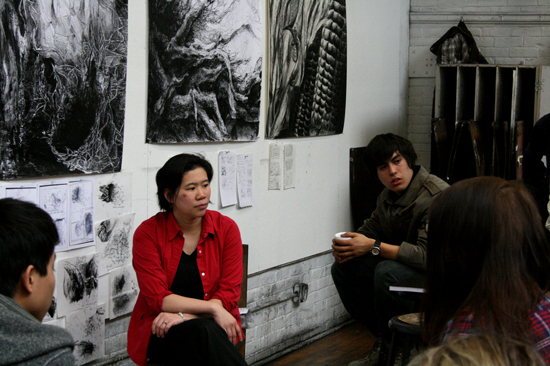"My friends and I are all beginning to look into graduate school and what our future may hold for us as fine artists. We range in age from our mid-20s to mid-30s and are at all at different stages of our adult life. We all dream the dream of being strictly a studio artist, and have considered the advantage of being professors one day. We all want to apply to the right graduate school to help set up our future, and don't want to be in a school that doesn't fit us. What advice do you have for students like us? How do we approach the hunt for graduate schools?"
Before you apply to graduate school for fine arts, you have to honestly ask yourself what your long-term goals are. Do you want to teach at the college level? Do you want to show in commercial art galleries? It may seem premature to think that far ahead, but it's important to think through and answer these questions before you leap into applying to graduate schools. When I was getting ready to apply, I primarily thought about graduate school as a place where I could mature as an artist, and continue to push myself creatively. I wasn't thinking ahead in terms of my future, and didn't realize that one of the most critical goals of graduate school would be making professional connections. No artist can build a successful career on their own; they have to make key contacts that will launch their careers in the right direction.
On top of that, I was not prepared for how obscenely competitive the process would be. Applications are continually growing at a rate that cannot match the scarce number of openings. When I applied, I assumed that I had done everything "right" up until that point: I had graduated with a high GPA from one of the top art schools in the nation; I had been consistently teaching and exhibiting my work professionally; my portfolio was mature and cohesive; and I had outstanding letters of recommendation. I was confident enough that I announced my departure at my teaching job before receiving the decision letters.
I received five rejections, was put on two waiting lists, and was offered admission only at my safety school. I was in complete shock. I was so ready to stop working and return to school. Having already quit my teaching job, it never even occurred to me to start over and re-apply the following year. I felt like I had no options, so I enrolled at my safety school with extreme reluctance. To this day, I regret that decision. Experience has shown me that there are doors that never opened for me because of that decision. If I could do it all over again, I would have taken off only one year (I took off four) after art school to clear my head, and then started the application process, knowing that it would likely take several years of applying before I was accepted to a program that I really wanted to be in.
In retrospect, I can see now that there are five main aspects to research when applying. There are other considerations like studio space which might seem important, but actually the five factors below carry far more weight.
1) The faculty.
Do extensive research on the faculty. What kind of artwork do they make? Does their work engage with a contemporary audience? What kind of venues do they show their work in? Have they had solo exhibitions at major galleries? Is their studio practice active? What is their online visibility? What is the turnover rate of the faculty and administration? (A high turnover rate is a red flag.)
2) Location.
Location matters in graduate school. For example, if your ultimate goal is to show in New York City art galleries, going to school in Kansas is not a good choice. The professional contacts you make will be based in the city the school is in, and these contacts can launch you right into that art community.
3) Teaching opportunities.
One of my colleagues told me that her biggest mistake was attending a graduate school that did not have teaching opportunities for their graduate students. The consequence was that when she started applying for college level teaching positions, she had no teaching experience and had difficulty getting hired. If teaching at the college level is a priority for you, make sure that the school you attend provides teaching opportunities for their graduate students.
4) Current student work.
Viewing the artwork being made by current students is one of the best ways to get a sense of the school. Can you envision yourself having a lively creative exchange with these students based on their artwork? Look for diversity in the student artwork; it's not a good sign when all of the student artwork looks the same. If possible, take a tour of the school and talk to some current students in person.
5) Alumni.
What are recent alumni doing? Where are they showing their work? Peruse their resumes online and try to get a sense of what kind of careers they have. Do they teach at the college level and if so, at what kinds of colleges? Do they have full-time or part-time teaching positions?
Remember, choosing a graduate school program is all about finding the right fit for you. Every artist has different goals, and a program that is right for one person may not work for you. Figure out where you want your artistic career to be in 20 years, and then find the program that will help put you on track to get to there.
Ask the Art Professor is an advice column for visual artists. Submit your questions to clara(at)claralieu.com

